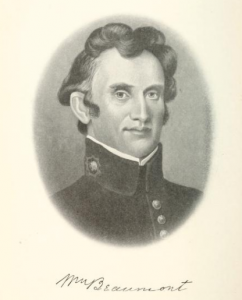On November 21, 1785, physician and physiologist William Beaumont, who became the first person to observe and describe the process of digestion in a still-living human, was born in Lebanon. Beaumont studied medicine by becoming an apprentice to Benjamin Chandler, an established physician in Vermont. At the time, apprenticeships were the most common means of acquiring a medical education. Beaumont went on to gain further surgical experience in the US Army as a surgeon’s mate during the War of 1812.

Dr. William Beaumont
While working as a post surgeon for the Army and as a private physician in Michigan, Beaumont had the opportunity to treat a young man, Alexis St. Martin, who suffered a gunshot wound to the torso in June of 1822. St. Martin survived but the treatment left a permanent hole, or fistula, leading directly to his stomach. This allowed Beaumont to observe the length of time it took this part of the digestive tract to process various types of food.
Encouraged to continue with his experiments by the Surgeon General of the United States Army, Beaumont studied St. Martin from 1825 through 1833. He published his results in Experiments and Observations on the Gastric Juice, and the Physiology of Digestion along with a table that outlined the average digestion times of different foods. His work also revealed the chemical nature of the digestive process and, in particular, the role of hydrochloric acid in breaking down ingested food products. Beaumont’s observations led to a new area of study, gastric physiology, focused on the function of the gastrointestinal system.








